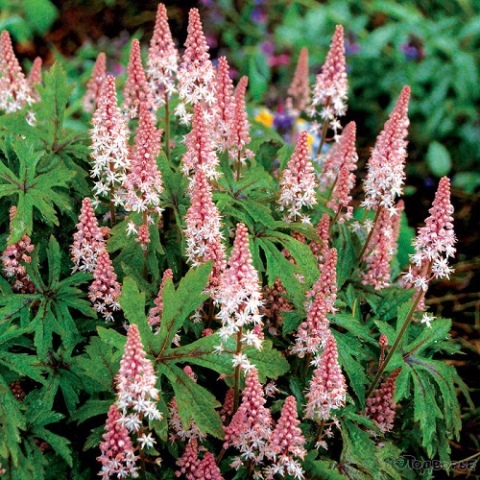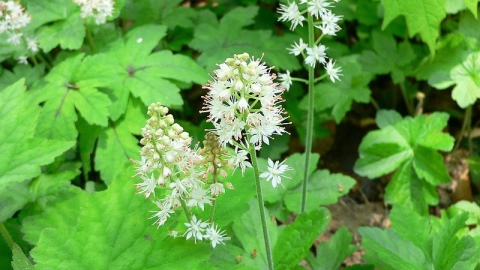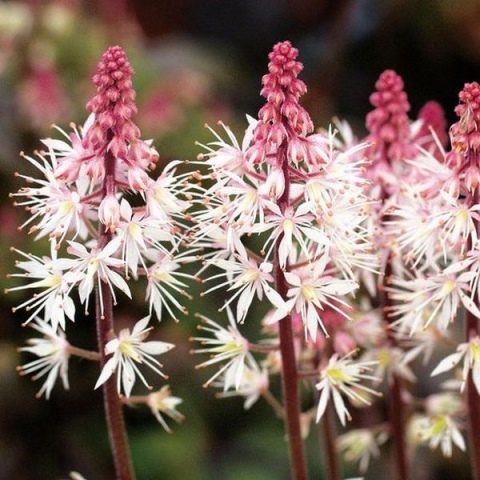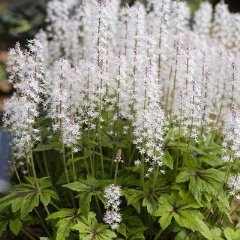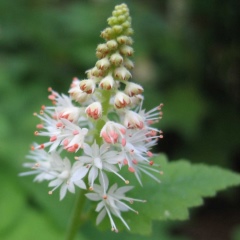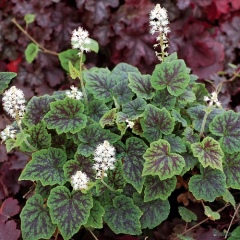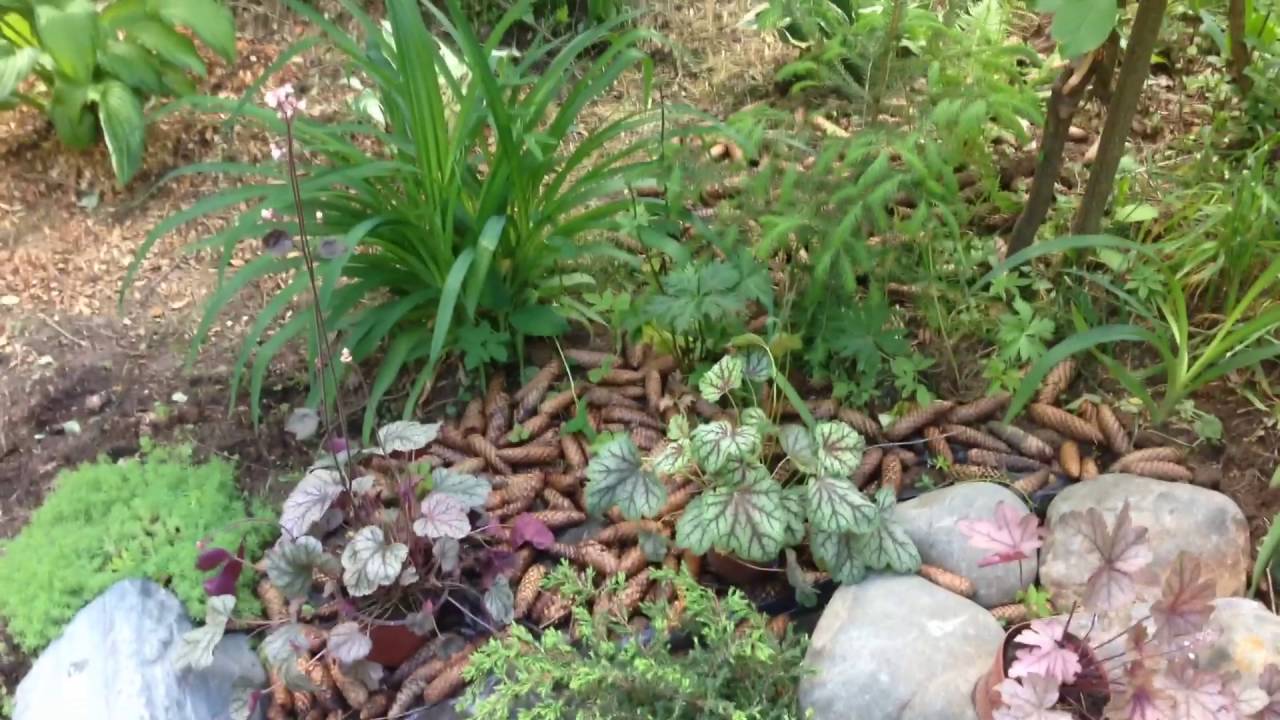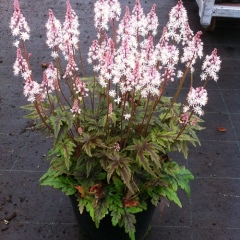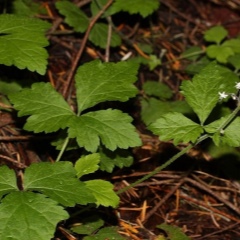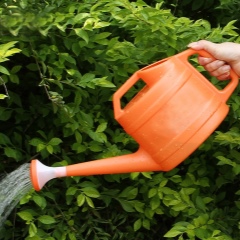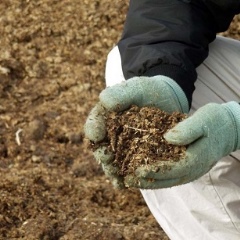Types of tiarella with names and photos
In cultural floriculture, several species are grown.
Tiarella cordifolia

Tiarella cordifolia Tiarella cordifolia planting and care photos in the garden
Up to 20 cm tall, with stellate white or cream flowers. It multiplies and grows quickly, and it stands out for the beauty of its leaves - graceful, slightly pubescent, on long petioles. They winter well, die off only in May, and new ones immediately appear to replace them. After flowering, the rosettes emit numerous creeping mustache shoots that form throughout the season and take root in each nodule.
During the season, one plant can form about 20 new ones. Quite quickly, it conquers the surrounding free space, as a result of which a dense cover is obtained. There are several interesting variegated varieties with bronze or purple spots, with prominent edging or veins. Actual use for carpet planting under shrubs and trees.
Tiarella wherryi
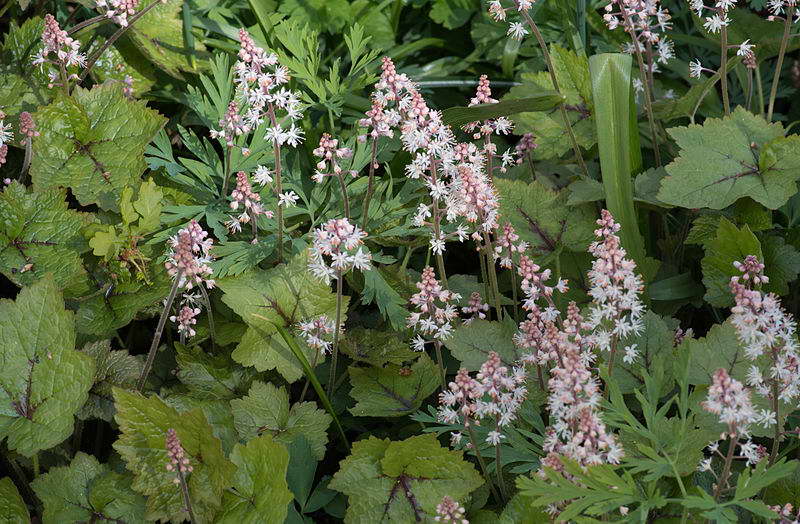
Tiarella Verri Tiarella wherryi photo in the garden
Up to 30 cm high, blooms from June to September with pinkish flowers. Bushes do not sprout, but grow less actively. It is less resistant to winter cold and requires additional shelter. Its leaf plates are more decorative, unusually and effectively colored, have a contrasting pattern in the center of the leaf plate.
Tiarella multifoliate Tiarella polyphyiia

Tiarella multifoliate Tiarella polyphyiia photo of flowers
It has peduncles with pinkish-cream flowers up to 50 cm. This species is not hardy enough, requires special measures to preserve it in winter.
Tiarella three-leafed Tiarella trifoliata

Tiarella three-leafed Tiarella trifoliata cultivation and care of photo flowers
It has a persistent and hardy character, it is considered the ancestor of many modern varieties. Squat bushes with carved leaves grow rapidly on loose forest soils, fluffy flowers are collected in spectacular sultans of inflorescences. Easily spread by self-seeding.
Tiarella unifolia Tiarella unofoliata
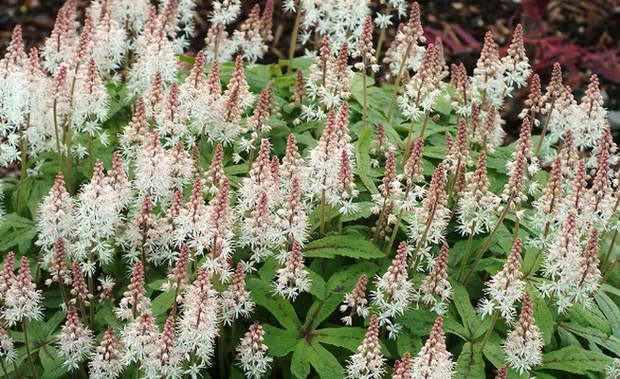
Tiarella unifolia Tiarella unofoliata photo of flowers
Wild species of large size. It is successfully grown by amateur flower growers in many regions of our country. Plant that is hardy to unfavorable conditions, frost-resistant.
Growing tiarella - planting and care: advice from florists
Tiarella for a shady garden
Long lasting beauty
There is always a shady spot in our gardens that is not favored by most flowering plants. Sooner or later, every gardener faces the question, but what to plant in such a corner where the sun does not look? A wonderful perennial plant - thiarella, which will feel at home in a shady place, can become a "magic wand" in such a situation.
Every year this plant wins the sympathy of an increasing number of flower growers who, along with shade tolerance, love tiarella for other advantages. Firstly, it is distinguished by its durability, decorative effect and a wide variety of varieties.
With age, its beauty is only gaining momentum, the bush grows, it becomes more magnificent and more beautiful every year. An undoubted advantage is also that the plant does not require special conditions of maintenance, tolerates transplantation, division of the bush, is drought-resistant, but at the same time loves moisture.
Even in winter, the bush will be beautiful, hibernating under the snow cover. All these advantages are enough to purchase this crop for your garden.
Types of tiarella
Thiarella leaves resemble maple leaves, but, depending on the variety,
they can differ in the degree of dissection and roundness of the edges. But all varieties are united by the presence of a contrasting dark pattern along the veins on a green background. The most cold-resistant and therefore widespread species in our latitudes is heart-leaved thiarella.It gives rosettes of leaves on long petioles up to 30 cm high.
With the help of creeping, strawberry-like whiskers that take root easily, the plant actively conquers space. Flowers -small bell-shaped light cream. However, in new varieties, they can be white, red, pink, purple. One of the varieties - Marmorata - has very decorative leaves: at first they are bronze-yellow, then they turn dark green with a bronze tint.
Another popular type is tiarella verry. It is similar to heart-leaved, but does not give a mustache and is less winter-hardy. It blooms with white or pink flowers in the form of asterisks.
There are also tiarella single-leafed, three-leafed and multi-leafed.
Growing
For thiarella cultivation to be a pleasure, the soils must be light and well-hydrated. Do not even think about a sunny landing site, since in the sun all the unusual color of the leaves is lost. Thiarella is fed twice a year - at the beginning of active growth and at the end of flowering. If, before leaving for the winter, you notice that the lower part of the bush is bare, then you need to huddle and mulch it.
Before buying, it is advisable to pay attention to frost resistance. In winters with little snow, the plant may suffer from wind and frost, so it is advisable to cover it with non-woven material.
Thiarella is an evergreen crop, in the spring its foliage can begin to evaporate moisture before the root system begins to replenish the plant's moisture reserves. This situation can lead to dehydration and death, therefore, during a rapid spring, it is advisable to irrigate with warm water, and shade the above-ground part if the sun hits it.
Reproduction
Thiarella can be propagated by vegetative methods (cuttings, dividing the bush), which always end successfully. For 3-4 years, the bushes grow so much that you will always have planting material in order to share with your neighbors or "decorate" some other shady place in your garden.
Growing and caring for tiarella
Tiarella is unpretentious to conditions and not demanding in care, relatively drought-resistant and frost-resistant, remaining decorative even in winter.
In the cool shade, without access to the scorching rays of the sun, it feels comfortable and grows quickly - it is often grown instead of a lawn.
Thiarella needs moist, fertile soil and a semi-shady place, as for any forest plant. But bright and variegated varieties should receive enough sun so that the beauties can fully show their beauty.
Planting tiarella after purchase
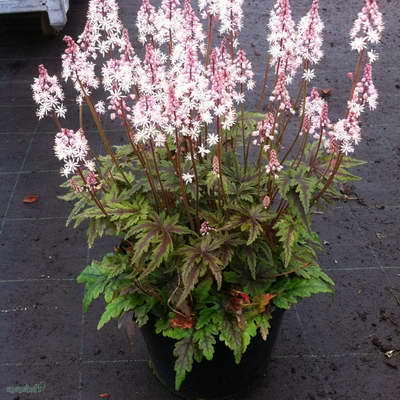
Planting tiarella outdoors
- Before planting, the wells are filled with organic matter and compost, placing the plants at intervals of approximately 25 cm.
- After planting, they monitor soil moisture, shade young plants from direct sunlight, weed and loosen in time.
- Thiarella develops well in loose and moisture-permeable soil with a slightly acidic and neutral reaction, without stagnant water.
After planting, the plant is thoroughly watered, so that the soil in the hole is completely wet. From above, you can mulch the earth with humus with a layer of 4-5 cm.
This will be an excellent way to retain moisture in the ground, prevent the formation of an earth crust and create an excellent microclimate in the ground, favorable for the development of beneficial microorganisms.
This will preserve the loose air-permeable structure of the soil, which is very important for plants during the rooting period.
How and how to feed tiarella
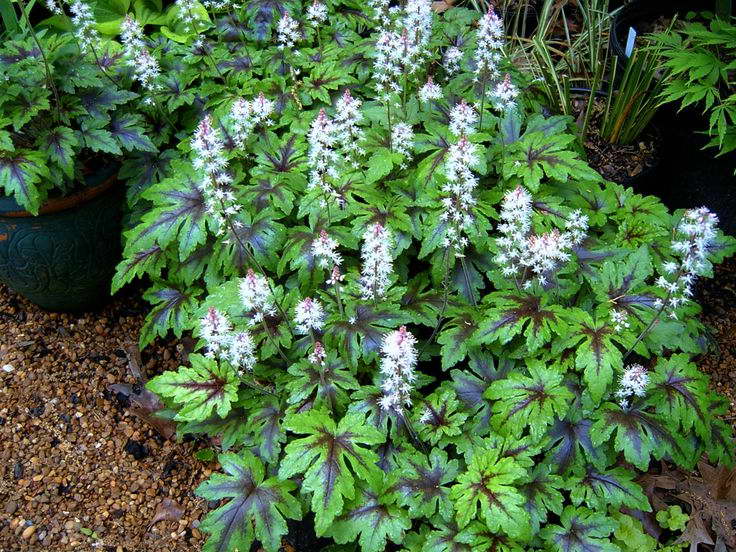
Tiarella in garden design photo of flowers
Needs fertilizing at the beginning of the growing season and after flowering. It is better to apply complex mineral fertilizers after watering, after diluting with water. Humic complex fertilizers or foliar dressing on leaves with fertilizers for flowering are perfect. The plant responds well to organic feeding. You can use fermented grass, rotted manure or bird droppings.
Before flowering, you can use regular nitrate, the main source of nitrogen. A good choice would be nitroamofosk, which will become a source of not only nitrogen, but also deliver phosphorus to the plant, which is necessary for planting flowers. Fertilizer consumption - a tablespoon with a mountain for 10 liters of water. The solution should be enough for watering 1 sq. M. area.
Shelter for tiarella for the winter
- Before the onset of winter, you should carefully cover the bases of the bushes with peat or mulch the area at the roots with fallen leaves.
- For young and recently transplanted plants, an additional cover of non-woven material is organized, which will help to avoid the loss of those specimens that are not yet well-rooted.
- They are in no hurry to remove the mulch in the spring, so as not to freeze the exposed parts of the rhizome.
Description of the tiarella plant and photos of flowers
It is worth starting the description of tiarella with the fact that its name comes from a Greek or Persian word meaning a specific headdress - a turban. Botanists noted the similarity with it in the inflorescences of the plant. The range in its natural environment covers areas of North America and Asia, namely China, Japan and both parts of Korea. In nature, the tiarella plant is an evergreen creeping perennial with a weak root system. As a horticultural crop, tiarka enjoys success due to its ease of cultivation and its unpretentiousness, as well as resistance to cold and frost.


Garden varieties of tiarka have high indicators of durability and decorativeness. Every year, the bush becomes even larger and more luxuriant, while not detracting from the picturesque nature of the inflorescences. The most popular is the type of heart-shaped thiarella, it is distinguished by the greatest frost resistance, therefore it is often grown in the gardens of the country. The growth of the bush reaches a maximum of 20 cm. On thin stems, beautiful openwork foliage is formed, in the summer of a rich green shade with bronze veins. In autumn, the leaf plate is completely colored red or brown.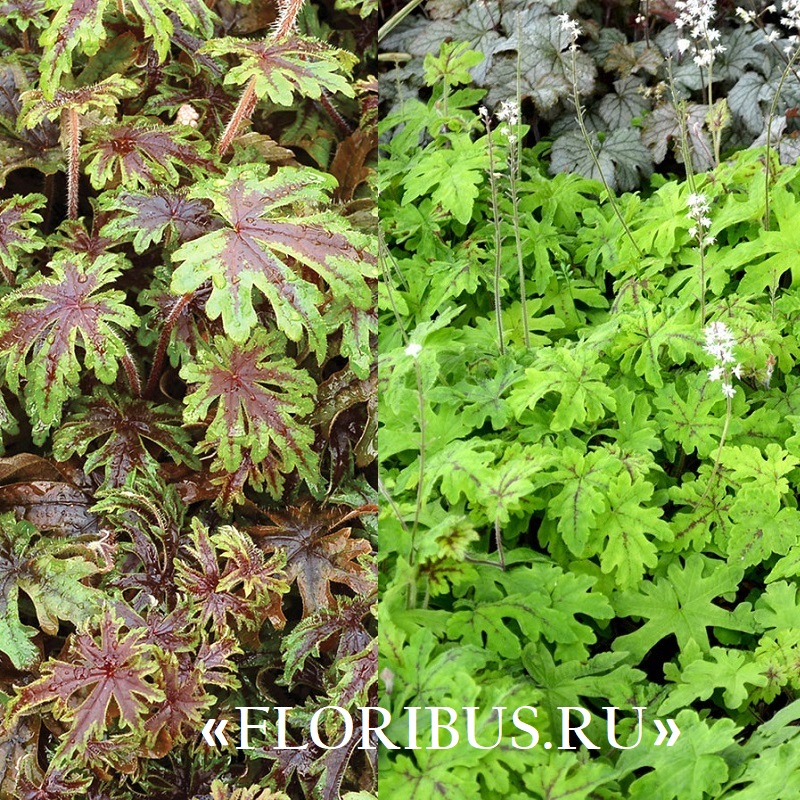
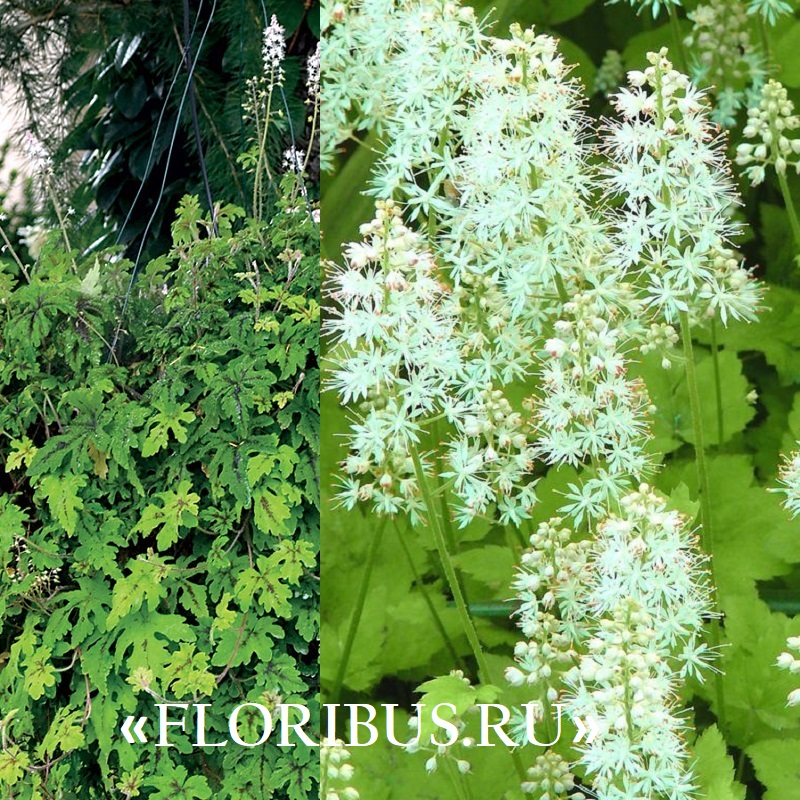

See what tiarella looks like - the photo of flowers shows the most graceful species and varieties: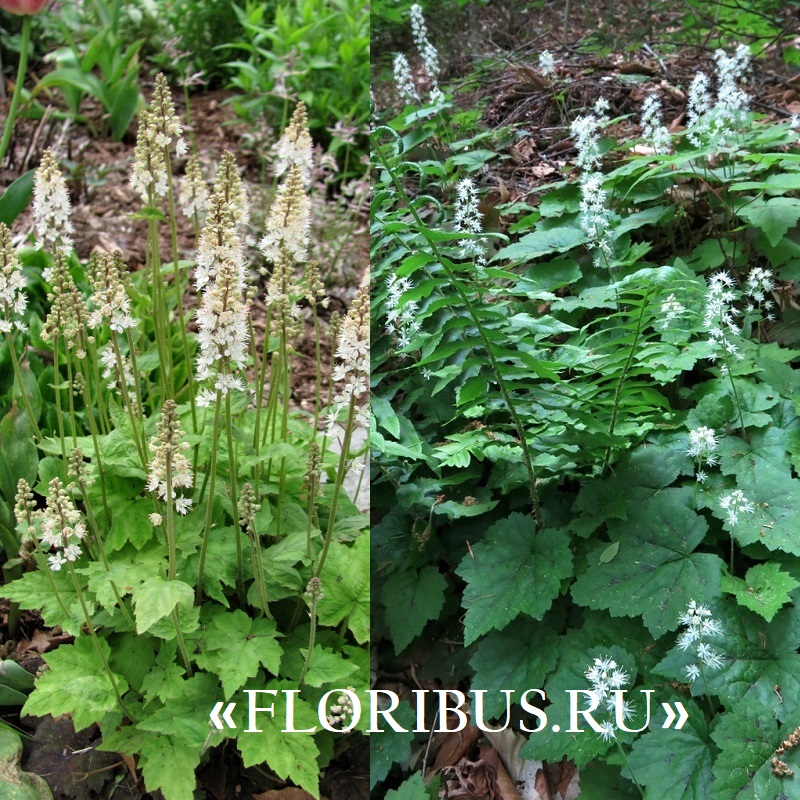


Tiarella care
Growing and caring for tiarka outdoors is easy, but still have several features. Consider them even at the landing stage:
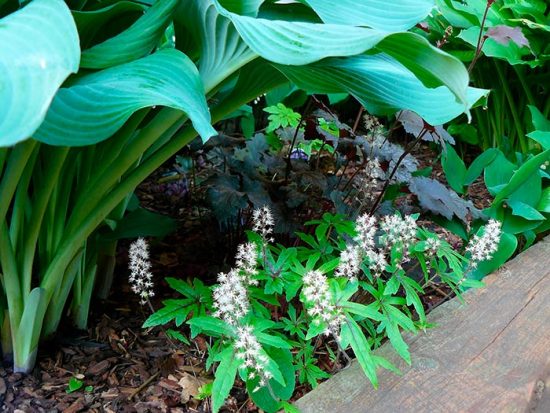 Tiarella feels good in the shade
Tiarella feels good in the shade
- The plant needs abundant watering. At the same time, keep the soil loose.
- Since tiarka is an evergreen crop, in March, when the sun warmed up, but the soil did not thaw, the plant may suffer from a lack of moisture. In this case, shelter from the rays or watering the entire bush with warm water will help.
- Tear off wilted flowers during flowering if you want to avoid self-seeding. The tiarka is very prolific, and in a couple of seasons it can cover more area than you gave it.
- All varieties of tiarka are cold-resistant to one degree or another. But it is better to cover them for the winter with non-woven material.
- Plants older than 3-4 years need winter protection without fail. They have a bare stem base. Bare roots spud and mulch in the fall.
- Aged bushes look unsightly due to bare roots. They are either covered with mulch, or dug up and divided for reproduction.
Botanical and hybrid species of Tiarella
In total, several studied botanical species of Tiarella are known, many of them are used in horticultural floriculture. The most popular variety is Tyarella cordifolia, which includes many natural and hybrid varieties. This species has become widespread as a garden culture due to its high frost resistance. In the wild, perennial evergreen bushes are found in Scotland and Alabama. The plant reaches a height of 20 cm, forming a large herbaceous spherical shrub. Leaves of cordial tiarella are round, cordate. Young tendrils are formed on the shoots, which allow the plant to grow rapidly in breadth. On the leaf surface, clear streaks of bronze or golden color can be noted.The buds are collected in very large racemose inflorescences. The perennial blooms profusely and for a long time - up to 30 days from May. The following interesting varieties of tiarella cordifolia are known in horticulture: Albiflora - white flowers, collected in numerous brushes
Iron Butterfly - large pinnately dissected foliage of rich green color with snow-white flowers in erect racemes
Spring Symphony - profusely long flowering
Appalachian - reaches 15 cm in height, bush diameter up to 90 cm, can be grown as an ampelous potted perennial
Pink Skyrocket - reaches 30 cm in height, pale pink inflorescences of star-shaped flowers
Silverado is a dwarf, up to 25-30 cm tall, bush diameter 20-25 cm
The heart-leaved hybrid thiarella is a verry variety. In Russian floriculture, it is used either as an annual or does not occur at all. It is actively cultivated in the gardens of the Southeastern part of North America. It is very similar in leaves and flowers to the previous described species, but it does not bloom so abundantly and is less winter-hardy. The flowers of the plant are white or pink. The most famous varieties of tiarella: Dark Eyes - dark purple areas are found in certain parts of the green leaf
Tiger Stripe - decorative foliage
Ninja - the leaf blade is dissected into several cirrus lobes with dark veins
Pink Bouquet is an abundant long-lasting bloom. Look at the variety in the photo of tiarella below:
Even less often, three-leafed thiarella, a perennial found in areas of North America, is grown in gardens. In this variety, the flowering stem can reach from 10 to 80 cm in height. The leaves are collected in a root rosette. On the stem there are more often 1-4 leaves or one single plate, up to 10-15 cm long. Flowers are collected in paniculate loose inflorescences. The fruit is a capsule.
One-leaved tiarella pleases with beautiful varieties - a large perennial plant, up to 50 cm high. In its natural environment, it is found in Canada and Alaska. Among the botanical varieties for horticulture, the following are used: Starburst - a frost-resistant variety with early flowering
Sea Foam - leaves are large, pinnately dissected
Cygnet - the leaf plate looks like a flying swan
Black Velvet is a very fast growing hybrid. Flowers are white or pink in clusters. There is a noticeable black and purple pattern on the leaves.
Planting and caring for tiarella outdoors
In order to safely plant a perennial on your site, you will need some knowledge about the plant itself and about caring for it. For planting tiarella, choose a shady area. It is best to maintain decorative flowering, so that the plant is placed in an openwork shade. Under the influence of direct sunlight, the perennial loses its picturesque appearance. Sunlight burns the leaf blades and burns out the flowers. In such conditions, thiarella will fade several times faster. Priming. The soil for planting is chosen light, even if the plant will grow at home, like a pot culture. The soil should be moist and loose. Slightly acidic and neutral formulations are best suited. In an acidic environment, the root system begins to rot. Reproduction is carried out by vegetative methods: dividing the bush and rosettes of leaves... In both cases, the planting material can be rooted immediately at a permanent growing site. The bush is dug up, the earthen layer is carefully cleaned off and divided into parts so that the cuttings are at least 3-5 cm long. You can grow young plants for some time in boxes with a mixture of peat, sand, ash and a large amount of organic matter. The most important thing when growing young animals is to observe the regime of frequent watering. Propagation using rosettes is possible by cutting off daughter plants from the mother bush and rooting them in a nutrient substrate until 2-3 new leaves appear. In some growers, thiarella quickly begins to multiply by self-sowing and becomes a weed. To avoid this, remove fading inflorescences in time.If you want to propagate the plant generatively - by seeds, then they are sown initially for seedlings. A pick is not carried out, since thiarella has a weak root system; if it is damaged, the plant does not survive in 80% of cases. You can sow seeds for seedlings from early March to late April.
Watering
An important part of caring for tiarella is scheduling watering for the plant. Water procedures should not be too frequent, but dry soil will also provoke the appearance of perennial diseases
The soil should always be slightly damp. In the heat, the number of watering procedures is approximately doubled.
Top dressing and transplanting. Overgrown bushes are transplanted, using reproduction by dividing the bush no more than 1 time in 2-3 years. You can feed the plants by alternating mineral and organic fertilizers during the active life period 1 time in 2-3 weeks.
Several years ago I decided to create a boxwood grove on my backyard. I decided to diversify the planting, revised many options for unpretentious and decorative flowers. The choice fell on tiarella, which is rarely found in Russia.
The plant took root surprisingly well and already in the second year began to grow strongly throughout the mixborder. In the article I want to share the intricacies of landing and care for tiarella in the garden.
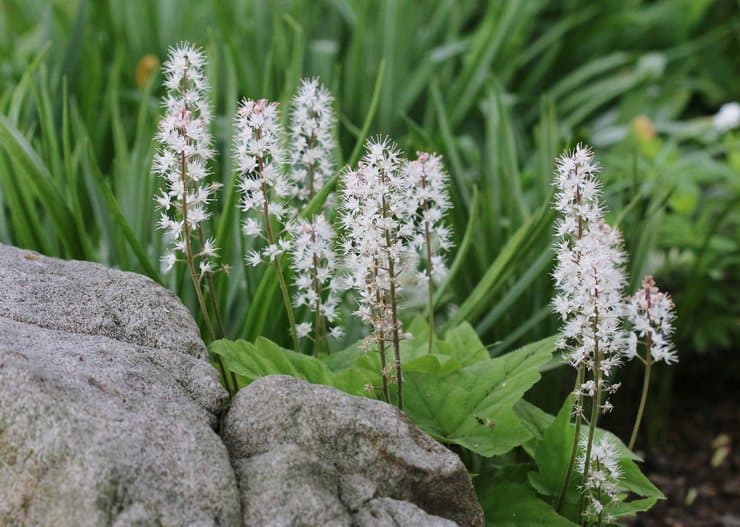
Types and varieties
The variety of types and varieties of tiarella, including hybrid ones, allows you to choose a plant for every taste.
Heart-leaved
Perennial ground cover, height does not exceed 30 cm. It has leaves of an openwork type, dark in color, there are varieties with spectacular foliage color, veins, edging. The flowering is creamy, shallow, the inflorescences are densely formed vertically. Winters well, grows quickly. In a short period, it can cover a large area with a lush carpet.
Among the popular varieties of heartwood, the following are distinguished.
- Pink Skyrocket is a perennial variety, height about 30 cm, flowers like a cone or rocket, blooms of a pale pink color. The foliage is large, similar to maple, with a mid-purple hue.
- Spring Symphony - a variety bred in North America, blooms extremely profusely, inflorescences are light, pinkish, like sultans.
- Jeepers creepers is a spectacular variety with delicate shade of green leaves that turn purple by the end of the season.
- Heronswood mist - refers to hybrids, the foliage is light green with a touch of pinkish or white tones, decorated with a spectacular brownish ornament. one of the few varieties that requires heat.
- Sugar and Spice is a variety with large, serrated foliage, dark purple veins, green background. The bloom is light pink.
- Sylvan Lace is a stunted representative of the species - no higher than 20 cm, the width of the bush can reach half a meter. Leaves are bright green, dark in the center. The flowers are white.
- Iron Butterfly - Its leaves are split type with a purple center. Cone-type flowering, light pink.
- Happy Trails - maximum crop height 15 cm, growth width 1 meter. A beautiful variety with green leaves, in the center they have a shade of dark purple, snow-white bloom.
- Angel Wings - plant height up to 25 cm, carved leaves, burgundy in the center, deep green at the edges. The flowers are fluffy, small, star-shaped, pink.
- Oregon Trail is a large leaf with a beautiful brown ornament.
- "Pacific Cross" - blade-like foliage with bright juicy greens, brown tone pattern all over the leaf.
- "Silverado" is a small plant with large foliage, decorated with patterns. The flowers are snow-white or pink.
- "Crowe phaser" - height up to 25 cm, large leaf plate, rich greens, covered with a touch of purple. The bloom is pink.
- "Mystic Mist" - maximum height 15 cm, the leaves gradually change color from pink to green with a reddish gradient pattern. The bloom is white.
- "Ninya" - a plant up to 30 cm tall, bright green foliage, dissected type with reddish veins.The bloom is light pink.
- The Appalachian Trail hybrid tiarella is a low-growing plant with a maximum height of 10 cm, growing up to 90 cm wide. Green foliage has a dark center with a pattern of brown tones, the flowering is snow-white, fluffy. Ideal for soil cover, ampel growth. It is unpretentious in leaving, it is enough to huddle and water it, you can periodically feed it. Grows well in partial shade or in the sun.
- "Verri" - the height of this perennial plant is up to 30 cm, there are no shoots on the sides, the growth is not too fast when compared with other types of tiarella. It is a compact bush with a beautiful white or light pinkish bloom. It blooms almost all summer, has a high decorative effect due to its spectacular foliage. The leaf plates have a rich green color and a contrasting ornament in the middle. Does not tolerate frosts too well, requires shelter.
- "Timbuktu" is a herbaceous perennial about 30 cm tall, shaped like a dense rosette. Large leaves are light, green with beautiful openwork, burgundy in the middle, veins of a purple tone. The flowering is light pinkish, the inflorescences are fluffy panicles. In length, the peduncle can reach a meter. It grows very quickly and requires large areas, it looks best growing in the shade.
Other types of tiarella.
- Many-leaved - not frost-resistant, requires shelter for the winter; bloom is beautiful, pale pink. The height of the bush can reach half a meter.
- Three-leafed - undersized type. The foliage is exquisite, carved, dark green in color. It grows at a high rate if the care is of high quality. The bloom is pale pink with fluffiness, the inflorescences are shaped like a cone. It tolerates winter well, is not capricious in leaving.
- Single-leaved. The height of this plant is about 45 cm. It grows well in any conditions, as it grows in natural nature, it is wild. The frost resistance of this tiarella is high.

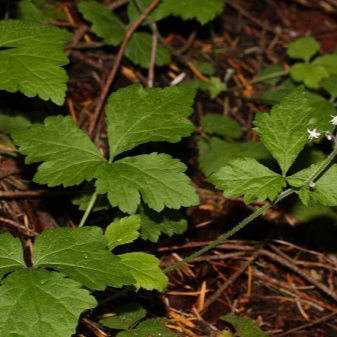
Reproduction of tiarella
Thiarella is propagated most often in a vegetative way. Strongly overgrown clumps with a bare base (as a rule, these are plants at 3-4 years of age) are dug up and divided with a sharp knife into separate fragments with several rosettes. The plots are planted in planting pits 30 × 30 cm in size, which are pre-filled with prepared soil with the addition of complex mineral fertilizer and ash.
Separate outlets can also be used for breeding. They are rooted in sand or peat-sand mixture (shading and regular moisture are required). It is advisable to cut and divide the bush before flowering, when each rosette will have 2-3 young leaves.
For varietal specimens, vegetative propagation is preferable, although the seed method is also practiced. Seeds are sown directly into open ground in March and April. No seed preparation is required. For even distribution over the surface of the substrate, they are mixed with sand. Under favorable conditions, thiarella produces self-seeding, therefore, the fading inflorescences should be cut off.
Class! Send Send
Growing from seeds
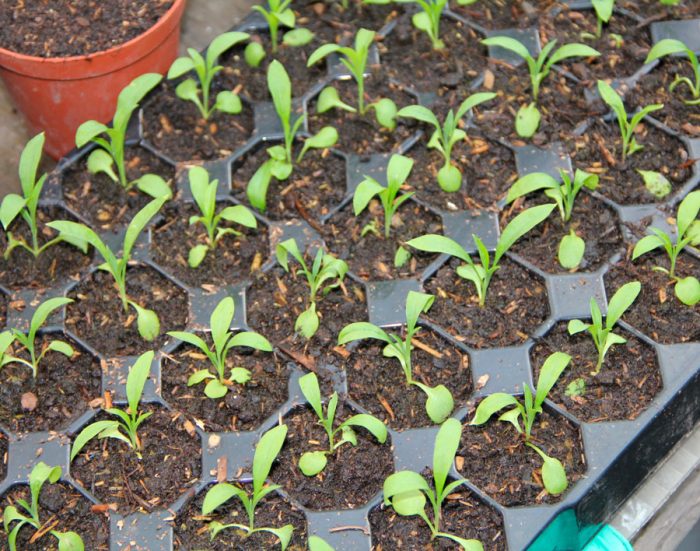
Sowing seedlings
Sowing Heirantus seeds for seedlings is carried out at the very beginning of the spring period. At the same time, grown seedlings are planted in a permanent place in the garden after about 2 months.
You will need a special seedling box or a wide container. To fill it, use a light soil mixture saturated with nutrients. Since the seeds are very small, it is recommended to combine them with sand before sowing. In this case, you will be able to sow them more evenly. Water the crops with a spray bottle, while on top they are covered with a transparent film or glass. Move them to a cool (16 to 18 degrees) place with diffused lighting. Do not forget to ventilate the crops every day, and also, if necessary, water them from a sprayer. After the appearance of the first seedlings, the film is removed.
The picking of seedlings into individual small pots is carried out after 2 true leaf plates are formed in it. Seedlings are transplanted into the garden only after the earth and air have warmed up well (from about mid-May).
It is recommended to grow only annuals through seedlings, while biennial varieties and species are recommended to be sown immediately into the garden.
Sowing in open ground
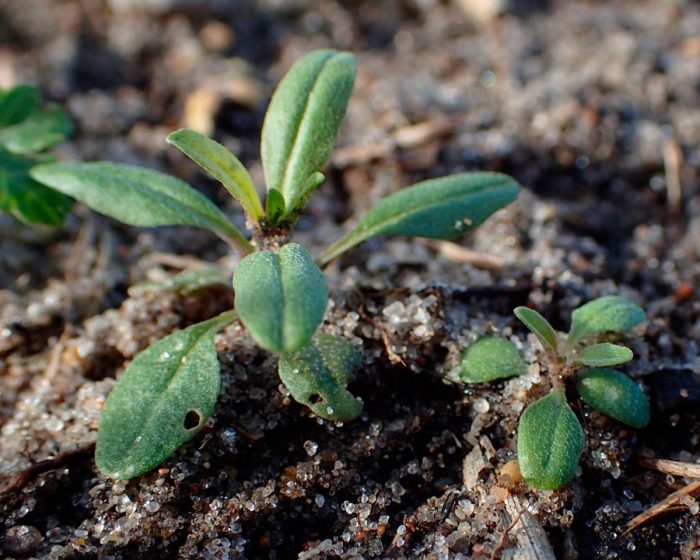
In open ground, the seeds of biennials are sown in May. Level the surface of the previously dug area and distribute the seed evenly over it. It should be embedded in the soil with a rake, and then the crops are moistened with a watering can. The seedlings that have appeared need to be thinned, while the extra bushes can be transplanted to another place.
In regions with frosty winters in August, heirantus is recommended to be dug up and planted in a pot, which is transferred indoors. This flower is able to withstand frosts down to minus 18 degrees, while adult bushes are more cold-resistant.
In regions with a warm and mild climate, jaundice is often sown before winter. And in such regions, it reproduces very well by self-seeding.



